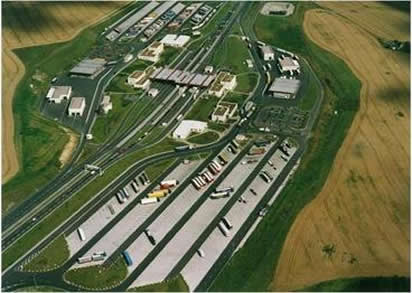Step 4. Understand the basic principles of cooperation across the border to the neighboring countries to speed up the border passage
Joint border controls
Definition/Scope
Joint border controls refer to the concept of two neighbouring Customs administrations entering into an agreement to operate Customs control jointly, i.e. to coordinate export and import controls, opening hours and competences. Ideally, joint controls are conducted in juxtaposed Customs offices where physical and technical infrastructures are shared.
Problem statement
At land border crossings, traders often have to undergo export formalities before they can accomplish the import formalities. In addition, the physical infrastructures of the export and import offices are often significantly different. This can lead to long border queues and clearance processes, in particular if inspections take place at both the export and the import side and competences and opening hours of the two Customs offices are not coordinated. For perishable commodities, this can lead to economic loss of the cargo.
Implementation guidance
The physical state of the border crossing is often a reflection of the relationship between two countries. A necessary prerequisite is therefore to establish fruitful and trusted relationships among neighbouring countries. On this basis, the operation of joint Customs controls and the establishment of juxtaposed Customs offices at common border crossings, as stipulated by Standards 3.4 and 3.5 of the Revised Kyoto Convention (RKC), will help to streamline the clearance process, eliminate redundancies and also strengthen Customs control capabilities.
Standard 3.3 of the RKC requests Customs administrations to coordinate opening hours and their respective competences to ensure a smooth and unhindered throughput at the border. In addition, the two countries should coordinate the physical layout of the border crossing in terms of the number of lanes, transit lanes, parking lots and other relevant facilities in accordance with Art. 6 of Annex 8 of the International Convention on the Harmonization of Frontier Controls of Goods.This requires the two countries to enter into negotiations on a bilateral agreement or treaty that will provide, among others:
- a legal basis for the budgetary commitments of the two countries to establish and maintain joint facilities and division of costs,
- definition of the border line,
- a legal basis for the officers from each country to exercise law enforcement measures (e.g. penalties, seizures, arrests) on the other country’s territory within the limits of the joint Customs office, including cases of hot pursuit.
Ideally, the treaty should also establish regular bilateral consultations at the local, regional and national levels to discuss operational and policy matters.
The picture below shows the border crossing in Ludwigsdorf between Poland and Germany, which provides a good practice example of such a common border crossing with joint facilities (Customs office, inspection area, parking lots, temporary storage, etc.) in each direction. The joint Customs office Ludwigsdorf is entirely on German territory, approximately 1 km away from the German/Polish border.

